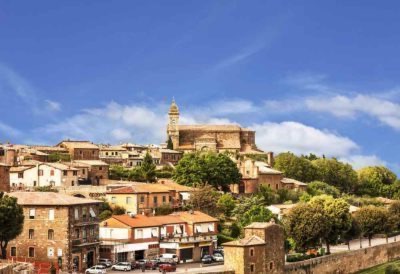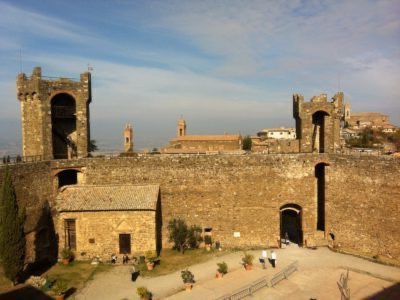The medieval fortress, the village and the delicious Brunello di Montalcino: here's what to do in this beautiful corner of Tuscany.
Montalcino it's a lovely one medieval Tuscan village, surrounded by walls and dominated by a magnificent fortress.
Montalcino's flagship product is Brunello. This famous wine was created in 1888 and from then on the fame of the country continued to grow until it became international. The well-known is held every year in July Jazz & Wine Festival of which famous jazz musicians are often guests.

When to visit Montalcino
I believe that the best time to visit Montalcino is in the very first days of spring. The town is still not too crowded with tourists and on the streets you can meet the residents and visit the workshops in complete tranquility. Entering the Fortress and walking through the typical streets you can breathe a typically medieval air, typical of many Tuscan villages. THE shops they give off scent of soap and flowers, i restaurants enchant with the smell of different delicacies and the gaze is lost in the bottles of wine that cover the walls of the wine bars.
With the increase in temperatures, the flow of tourists also increases, which lasts until late autumn, and which makes the country particularly lively. In summer it is a pleasure to wander through the residential and more peripheral streets of the historic center because they offer enchanting glimpses. Windows and terraces are literally covered with delightful colorful flowers.
Where to park
The most convenient parking area in Montalcino is located at the foot of the Fortress. His name is Camper rest point o Albergheria parking and is free. It consists of a large dirt area from which you can already enjoy an enchanting view of the Fortress from below. The village can be reached in less than 5 minutes on foot, using a convenient pathway with fence, well indicated by signs, adjacent to the entrance to the parking lot.
A smaller parking area with a parking disc for 2 hours is that of Spedale meadow, however close enough to the center (less than 10 minutes on foot).
Instead that of Viale Strozzi it is a large paid parking and is located behind the Cathedral of the Holy Savior.
The historic center is not very large and can be easily visited in one day.
1. The Fortress
La Fortezza with a pentagonal plan, it was built in 1361, when the city passed under the dominion of Siena. The mura instead they date back to the thirteenth century and the village it has not undergone major changes from the XNUMXth century to today. The context in which the Rocca is located is therefore similar to the original one and is in a good state of conservation.
The monumental entrance to the Fortress is preceded by a wide staircase and admission is free. From the inside the gaze inevitably falls on towers guard corners. Access to the walkway it is paid and takes place through the Enoteca della Fortezza, but from up there you can enjoy a magnificent view that sweeps from Monte Amiata to the Ombrone Valley.
I suggest you inquire about any cumulative tickets for the Fortress and the Civic and Diocesan Museum.
2. The Civic and Diocesan Museum of Sacred Art
Entrance to the Civic and Diocesan Museum it is located in Via Ricasoli 31 and occupies part of the Convent of Sant'Agostino. There you can see how the local artistic production has changed over time, especially from the Middle Ages until the twentieth century. It also houses works by great artists such as Ambrogio Lorenzetti e Simone Martini.
In the nearby Piazza Garibaldi instead is the Astrusi Theater. It was built in the second half of the eighteenth century but has undergone several subsequent changes. It was recently put back into operation, in fact today it hosts the staging of many shows.

3. The Piazza del Popolo and the Duomo
The third stage is definitely Piazza del Popolo, where the Palazzo dei Priori with its slender tower with clock and gothic loggia.
From the north end of the square, turning left and following a slightly uphill street, you can see the Cathedral of Montalcino, also called Cathedral of the Holy Savior. From a first glance you can see that the style is different from the rest of the buildings in the city, in fact it dates back to the XNUMXth century and is of the neoclassical school. The austere construction we see today replaced the ancient Romanesque church that was in its place.
4. The Borgo
After visiting the Duomo, don't be afraid to get lost among the alleys of the historic center and to visit the other churches you will encounter, such as the Church of San Pietro and the Church of the Madonna del Soccorso. Proceeding north you will reach the end of the historic center, and there you could take Via Strozzi to take a long walk on the walls with a splendid panorama on the surrounding hills.
Then savor a good Tuscan lunch in one of the many osterie and visit the workshops of the artisans to be fascinated by the skill of their hands. Before leaving, however, don't forget to take home a bottle of good Brunello to return to Montalcino with a single sip of wine.

If you go to Montalcino and you have more than one day available, you could combine a visit to Pienza or Castel del Piano. Both in winter and in summer, Monte Amiata also has its charm, and is located just over 10 km from Montalcino. To fully enjoy it, I recommend that you dedicate a whole day of sport or relaxation to it.


























